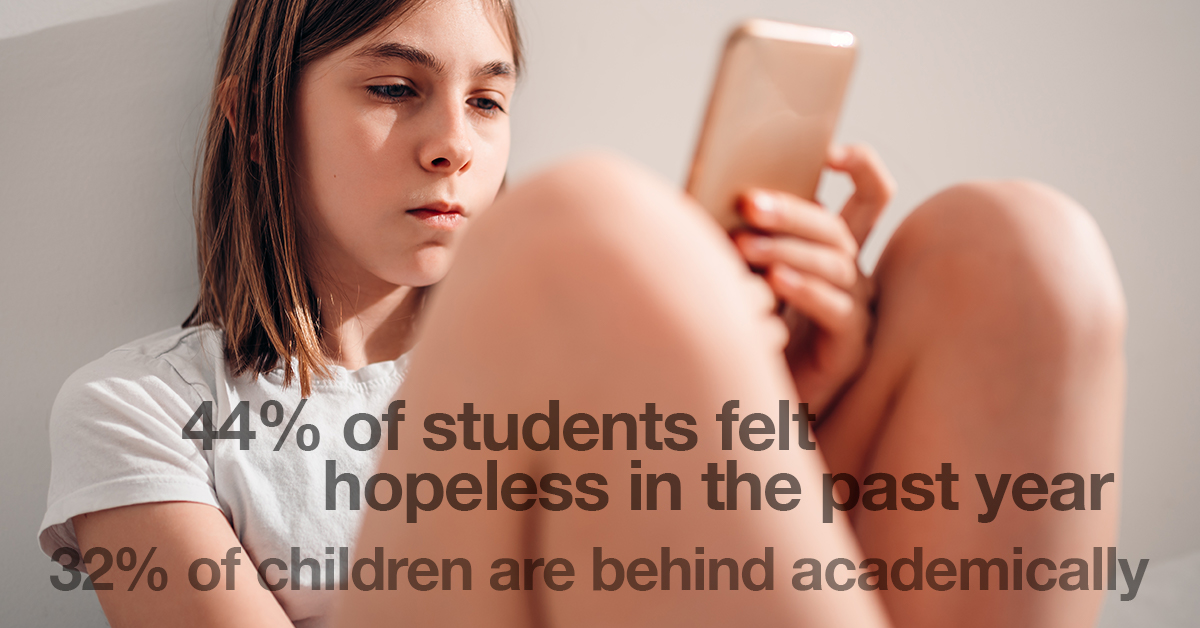By Jayne M. Wesler, Esq.
May is Children’s Mental Health Awareness Month. The worldwide pandemic starting in March 2020 has been hard for adults and children alike. For children, however, the challenges have been magnified since they often have little control over their lives, and most are not developed or mature enough to recognize what is happening to them. While statistics show that mental health challenges have been rising for our student population in the last decade, COVID-19 has multiplied the problems.
How widespread are the issues?
Almost half of all parents in the United States report that their children have struggled with mental health issues. This is staggering. Even more, parents reported that their children fell behind academically in the two-year span from March 2020 to March 2022.
The National Parents Union conducted a survey of 1,000 parents of K-12 students. Their responses demonstrated that 48% of students have had mental health challenges in the past two years. Half of the parents indicated that their children have overcome those challenges, while the other half continue to struggle.
There are 51 million children in public schools in the United States today. This survey indicates that 25 million children have been affected significantly by mental health struggles in the past two years and that 12.5 million children are still not okay.
What effects are we seeing on children?
The difficulties faced by the nation’s K-12 school children fall into the following categories:
1. Mental health issues.
a. The CDC polled over 7700 students in an effort to assess their level of distress and need during the COVID-19 pandemic. The survey found that 44% of students felt hopeless in the past year, so much so that it had affected their ability to function normally in their daily lives. A full 20%–that’s one in every five students –had even contemplated suicide.
b. The number of minors waiting for psychiatric beds almost doubled in certain areas in February 2022.
c. The Brookings Institute estimates that over half of students with mental health issues in 2019 were not provided with treatment.
d. Moreover, the Journal of the American Medical Association in its research discovered that the number of students aged 3-17 who were diagnosed with anxiety increased by 29%, and those diagnosed with depression rose by 27%.
2. Academic issues. Sixty-six percent of students had trouble finishing their homework. Parents reported that 32% of their children are behind academically, and 28% of that group were “very behind.”
3. Social skills issues. The isolation necessitated by the COVID-19 pandemic increased the social skills struggles of students and decreased their competency. As a result of lockdowns, remote schooling, disruption of extra-curricular activities, and lack of socialization, many parents find that their children’s social skills have fallen behind or have been delayed in their development.
4. Behavioral challenges in school. The United States Department of Health and Human Services reported that the increase in anxiety and depression has led to a 21% increase in the behavioral and conduct problems in the nation’s students.
5. Bullying and abuse.
The website Admissionsly reported that:
a. 4.2% of students had been bullied by teachers occasionally and 5% very frequently.
b. 3.2% of students had bullied other students occasionally and 1.9% very frequently.
c. 49% of children in grades four to 12 have been bullied by other students at the school level at least once.
d. 20% of the US students in grades nine to 12 reported being bullied.
e. 71% of youth have witnessed bullying at school.
f. 70% of school staff have reported being a witness to bullying.
g. Statistics on Facebook bullying found that at least 1 million kids were bullied on Facebook in 2017 alone.
h. 55% of students reported that the adults in their households had cursed at them or verbally insulted them. 11.3% were victims of physical abuse.
What can parents, schools, and communities do to address the challenges?
Ask if they need help, or even what kind of help they need. Make it easy for them to take it. Parents, relatives, school staff, and community members can make it their business to keep watch on the children in their spheres. Don’t wait for a child or teenager to seek out help. Young people often do not have the skills to make such a request, especially if they are feeling overwhelmed, depressed, anxious, alone, or even suicidal. They may believe that no one cares.
Provide mental health counselors, check-ins with trusted school staff, and student mentoring. One way school districts can help students cope with the overwhelming demands of life in the COVID-19 era is to provide school psychologists and school social workers to counsel students and provide support. However, school psychologists and school social workers are in short supply.
Ask community leaders and legislators for help. Make your voice heard and your issues known. Many states have received COVID-19 funds. Find out if your community or school district could benefit from those monies to hire more staff and provide resources for students in need.
Train more people to assist students. Be they parents, community members, teachers, clergy, or other community members, people can be trained to provide support and assistance to students in need.
As always, if you have questions about your child’s academic, social, emotional, or behavioral needs in school, please call us for a consultation. The attorneys at Sussan Greenwald & Wesler have decades of experience and are ready to help. Call today at 609-409-3500.


